 University of California, Berkeley Astronomers have discovered the largest black holes known to date. The black holes are estimated to be have masses equivalent to about 10 billion suns each (one black hole being slightly bigger than the other). The two black holes are in clusters of elliptical galaxies greater than 300 million light years away (1 light year is approximately 5.8 trillion miles).
University of California, Berkeley Astronomers have discovered the largest black holes known to date. The black holes are estimated to be have masses equivalent to about 10 billion suns each (one black hole being slightly bigger than the other). The two black holes are in clusters of elliptical galaxies greater than 300 million light years away (1 light year is approximately 5.8 trillion miles).
A black hole is an area in space where gravity’s pull is so tremendous that light cannot escape; gravity has been squeezed into such a small space that the density of the object and the pull it exerts is incomparable to anything else known to man. Astronomers are able to detect black holes by the effect the gravity has on things around it. High-energy light is also created when a black hole and star are close together; this occurs because the material spiraling into the black hole compresses and heats and some of this heat escapes as radiation. This kind of high-energy light can only be seen with satellites and telescopes in space.
According to the famous physicist, Albert Einstein, because of their massive scale, planets and stars dramatically warp space-time. Think of a baseball placed in the middle of a stretched out sheet of cloth. A much smaller marble moving along the sagging cloth will be drawn towards the heavier baseball as it is sagging the cloth inward towards itself. Likewise, the Earth is drawn towards the heavier Sun; the reason the Earth does not fall into the Sun is because of the fast speed at which it moves (about 18.6 miles/s).
Actually, based on Einstein’s theory of general relativity, time and space are tightly intertwined, and changes in space cannot be made without affecting time. Further, a black hole should have a profound effect on time – warping it to such a degree that time slows drastically. So, theoretically, if you were somehow abe to travel to space and get close to a black hole, in a matter of minutes, years would go by on Earth. Sounds like a science fiction novel doesn’t it!
University of Berkeley Astronomers Discover Largest Known Black Holes
This entry was posted in Astronomy, Physics, Science and tagged Albert Einstein, Astronomers, Berkeley, black hole, blackhole, general relativity, Largest Blackholes, theory of general relativity, time travel, University of California. Bookmark the permalink.



 Twitter
Twitter LinkedIn
LinkedIn Youtube
Youtube RSS
RSS